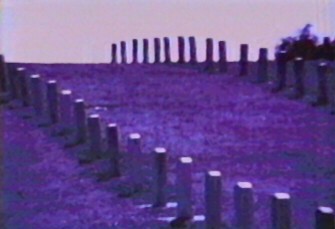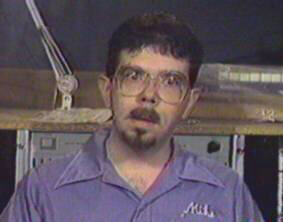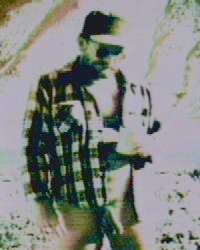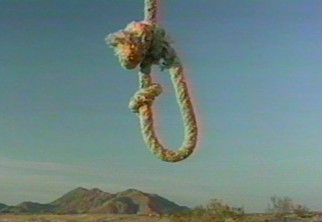Lingering-Epiphany and other videos
by Michael Schell
 NOTE:
the following are program notes to the videotape Lingering-Epiphany and other
videos, a remastered compilation tape released in 1996 by Franklin Media Distribution. The tape can be purchased on-line
from Flicker. Lingering-Epiphany is
viewable online at
Vimeo.
NOTE:
the following are program notes to the videotape Lingering-Epiphany and other
videos, a remastered compilation tape released in 1996 by Franklin Media Distribution. The tape can be purchased on-line
from Flicker. Lingering-Epiphany is
viewable online at
Vimeo.
This compilation gathers my most important video works between 1984, when I
began working in the medium, and 1991, when I shifted my attention to intermedia
performance. During this time I produced a series of experimental videotapes
featuring synthesized imagery and music, and exploring the relationship between
sign and object in contemporary society.
All of the tapes, except for Just Words, can be considered music
videos, provided we can divest that term of its commercial connotations. The
imagery and music are my own, and both employ elaborate analog and digital
processing techniques. This serves two main purposes beyond the sheer erotic
exploration of color and timbre. First, it helps to convey senses and emotions
not otherwise available in a strictly audio/visual format. For instance, the
restricted color pallet of yellows and reds used for the desert footage in Lingering-Epiphany
serves to suggest the intense heat and dryness of the locale.
Second, varying the recognizability of individual images and sounds helps
avoid the closure of simulationism, in which everything is made to look and
sound as realistic as possible. I've long felt that the commercial media's
reliance on ultrarealism blurs the distinction between real images (actual
people and things) and artificial images (what you see on television).
Personally I never want to forget that what I'm dealing with in video is a machine.
Thus in looking back over these tapes, I think their guiding principal is openness:
of form, aesthetics and meaning. In light of the astonishing international
events of recent years, driven by the desire of people to open previously closed
societies, I feel that a commitment to artistic openness is more important today
than ever.
 I've
long been interested in the human ability to attach arbitrary values to things. Just
Words explores this propensity with an eye to language. In particular, I ask
why we consider certain words "obscene"? Is it because of their
phonetic characteristics? (But compare shit and sheet.) Or their
semantic characteristics? (But compare shit and dung.) Perhaps it
is a matter of context: obscene words are often employed in a state of hostility
or frustration. But in Just Words the words are not directed at any
particular viewer. They are fragments, devoid of syntax. They approach a pure
state of meaning borne solely of our preconceptions and associations. Without
those, the obscenities, like the harmless monosyllabic nouns accompanying them,
are mere sounds.
I've
long been interested in the human ability to attach arbitrary values to things. Just
Words explores this propensity with an eye to language. In particular, I ask
why we consider certain words "obscene"? Is it because of their
phonetic characteristics? (But compare shit and sheet.) Or their
semantic characteristics? (But compare shit and dung.) Perhaps it
is a matter of context: obscene words are often employed in a state of hostility
or frustration. But in Just Words the words are not directed at any
particular viewer. They are fragments, devoid of syntax. They approach a pure
state of meaning borne solely of our preconceptions and associations. Without
those, the obscenities, like the harmless monosyllabic nouns accompanying them,
are mere sounds.
The romantic conception of nature (as the holder of the infinite) and of
scientific inquiry (as the striving for the infinite) forms the basis of a
dialectic explored in Higher Laws. Synthesized images of
scientists and technicians working in research laboratories alternate for
several minutes with outdoor scenes shot in the American west. At the end of the
work the dialectic is brought together by an extended sequence shot during a
service expedition to a remote seismometer in the Sierra Nevada. The
accompanying music is also based on a dialectic, alternating between a
rhetorical density music using synthesized sounds, and a lyrical, sinuous music
for solo viola (played by Marlow Fisher). The title Higher Laws suggests divine
truths as well as empirical theories. But the specific reference is to Thoreau:
"We are most interested when science reports what ... men already
know practically or instinctively, for that alone is a true humanity, or
account of human experience."
The work was produced in 1990, when scientists were beginning to warn us
about ozone depletion and global warming. As I write this, there is hope that
the world is emerging into a new environmental awareness. I'd like Higher
Laws to be viewed within the context of this hope.
Lingering-Epiphany, is a portrait of deserts: Mojave, the slums, the
Cross and the quiet mind. To some, a desert is a place with an arid climate. To
me, it is anyplace where life persists in a harsh environment.
The Mojave Desert, like the rest of the American West, projects an
overwhelming sense of loss. A loss of innocence, since it has been defiled by
roads, cities and aqueducts, and a loss of history, since its rich past is
visible only in traces: an abandoned mine or an Indian rock drawing. It is a
place which thousands cross every day in cars and trucks, but where one is still
profoundly alone: the perfect metaphor for the postmodern condition. The squalor
of our urban deserts also speaks of loss and abandonment: the street people
standing around, the boarded up buildings: all signs of past lives and
affluence. Likewise, the Cross is a symbol of the past, of an antiquated
religious context whose eloquence is long lost. Splattered across the urban
landscape, it is no longer an object of particular significance, but is simply
part of the environment, like the sagebrush which blankets the West.
The imagery unfolds in an austere pallet of monochrome yellows, browns and
reds. The accompanying score is a collage of distant sounds: trains, birds,
metal instruments. It is harsh and ambiguous music. At the end of the work, a
cross-shaped tombstone appears, incongruously, in a desert gully. The music
relents and softens, suggesting the quiescence one often feels during a
religious experience, or while alone in the desert.
A feeling of aloneness continues in Inclined Temple, whose central
theme is the way that altars serve as an abstraction of objects and places which
hold divine qualities or deep personal significance. This tape is both mystical
and nostalgic, dwelling on the complex emotions which can surround the memory of
a particular place or thing. The music alternates between abstraction (featuring
synthesized sounds and symmetrical pitch structures) and concretion (featuring
an Apache fiddle), and the imagery alternates between religious icons and images
of more personal importance: a Korean gift basket, an abandoned fire lookout and
friend's personal altar of scrap metal, barbed wire and detritus, visited on a
snowy day.
The mirrored images were suggested by the geometric patterning of Dineh sand
painting (itself one of the image sources), and recall the bilateral symmetry
common in altarpieces. The pallet features soft pastel colors, and was suggested
by the paintings of Duchamp, themselves imbued with a patina of intellectual
mysticism.
 Selfsame
takes us in a more social direction. Clearly it is about men, and our
self-images, our personae. But it is also about all kinds of personal
presentations, the contrast between the intimate self and the packaged self, and
the ultimate realization that the sophistication of the latter does not erase
the former. Beneath the unsullied facade of Wall Street executives lie men who
indulge in the universal rituals of dressing and undressing, defecating,
masturbating. The rigid code of dress and behavior promulgated by the
chronically tie-clad agents demonstrates the disqualification of the body: it is
relegated to the circulation of signs, which is the realm of all produced and
consumed objects. Unlike the other videos in this collection, Selfsame
was shot almost entirely on film, which was hand-processed before being
transferred to video for editing and further manipulation.
Selfsame
takes us in a more social direction. Clearly it is about men, and our
self-images, our personae. But it is also about all kinds of personal
presentations, the contrast between the intimate self and the packaged self, and
the ultimate realization that the sophistication of the latter does not erase
the former. Beneath the unsullied facade of Wall Street executives lie men who
indulge in the universal rituals of dressing and undressing, defecating,
masturbating. The rigid code of dress and behavior promulgated by the
chronically tie-clad agents demonstrates the disqualification of the body: it is
relegated to the circulation of signs, which is the realm of all produced and
consumed objects. Unlike the other videos in this collection, Selfsame
was shot almost entirely on film, which was hand-processed before being
transferred to video for editing and further manipulation.
Mea Culpa was originally inspired by a notorious series of experiments
conducted in the 1960s by social psychologist Stanley Milgram, in which
assistants were recruited to administer electric shocks of progressively
increasing intensity to subjects who failed to master simple memorization tasks.
Upon prodding by the experimenter, whose commanding presence and white coat
conveyed authority, many of the assistants willingly administered severe and
potentially lethal shocks to the helpless subjects. Unknown to the assistants,
these subjects were actually Milgram's confederates and were not harmed; the
assistants were the "true" subjects in the experiment. Mea Culpa
is the result of my reflections on the notion of banality of evil, the
sense of obligation and duty that impels normal people to participate in
aggressive behavior.
 The
work opens with an adult man bathing nude in a mountain pool. This is intercut
with pictographs, and accompanied by an aural collage of religious chanting from
various Western and non-Western cultures, serving to establish the work's
essentially humanistic theme. While the opening emphasizes the individual's
relation to the self, the heart of the piece focuses on the individual's
integrative relation to others. An extended stream-of-consciousness unfolds,
incorporating the many dimensions of social interaction: people talking, working
and playing together in various relations of authority, subordination and
peerage. Over this montage, images and sounds recorded in Milgram's actual
experimental trials continually emerge, like a recurrent nightmare or flashback,
reminder of the psychotic threshold which society passes when it begins to
overvalue its members' capacity for obedience.
The
work opens with an adult man bathing nude in a mountain pool. This is intercut
with pictographs, and accompanied by an aural collage of religious chanting from
various Western and non-Western cultures, serving to establish the work's
essentially humanistic theme. While the opening emphasizes the individual's
relation to the self, the heart of the piece focuses on the individual's
integrative relation to others. An extended stream-of-consciousness unfolds,
incorporating the many dimensions of social interaction: people talking, working
and playing together in various relations of authority, subordination and
peerage. Over this montage, images and sounds recorded in Milgram's actual
experimental trials continually emerge, like a recurrent nightmare or flashback,
reminder of the psychotic threshold which society passes when it begins to
overvalue its members' capacity for obedience.
The work's coda is devoid of any sign of human presence. Sparse, distant
music accompanies the image of an old quarry frame and a cemetery. Both are
abandoned: uninhabited traces of former life and activity. Besides balancing the
earlier polarities of individual and group identity, this ending completes the
metaphor of a passage from birth to death: that of the self, or perhaps of an
entire society or race.
- Michael Schell, November 1996
Michael Schell: LINGERING-EPIPHANY and other videos
- Higher Laws. Duration 10:35, completed 1990, dedicated to Reynold
Weidenaar
- Lingering-Epiphany. Duration 10:37, completed 1990, dedicated to
Caroline Avery
- Inclined Temple. Duration 6:16, completed 1991, dedicated to Jeff
Ray
- Selfsame. Duration 8:15, completed 1987, dedicated to Tom Chomont
- Just Words. Duration 3:52, completed 1984, dedicated to Kenneth
Gaburo
- Mea Culpa. Duration 14:20, completed 1989, homage to Stanley
Milgram 1933-1984
56 minutes total. Videotapes produced through residencies at the Experimental
Television Center (Owego, New York), Film/Video Arts and the Center for
Electronic Music (New York), the Center for Computer Music at Brooklyn College,
Real Art Ways (Hartford), the Community Programming Center at Heritage
Communications (Iowa City), and the Corroboree Gallery of The University of
Iowa. Additional support from the Electronic Arts Grants program of the Experimental
Television Center, supported by the New York
State Council on the Arts, the Media
Alliance ON-LINE program, Meet the Composer, Harvestworks
and the Experimental Intermedia Foundation. Special thanks to Sherry Miller
Hocking, Phill Niblock and Mary Ann Toman.
Video and music copyright © 1984–1991 by Michael
Schell. Text and compilation copyright © 1996 by Michael
Schell
 For more information, contact
Michael
Schell (webmaster@schellsburg.com).
For more information, contact
Michael
Schell (webmaster@schellsburg.com).


Original Material and HTML Coding Copyright © 1996–2016 by Michael
Schell. All Rights Reserved.
 NOTE:
the following are program notes to the videotape Lingering-Epiphany and other
videos, a remastered compilation tape released in 1996 by Franklin Media Distribution. The tape can be purchased on-line
from Flicker. Lingering-Epiphany is
viewable online at
Vimeo.
NOTE:
the following are program notes to the videotape Lingering-Epiphany and other
videos, a remastered compilation tape released in 1996 by Franklin Media Distribution. The tape can be purchased on-line
from Flicker. Lingering-Epiphany is
viewable online at
Vimeo. I've
long been interested in the human ability to attach arbitrary values to things. Just
Words explores this propensity with an eye to language. In particular, I ask
why we consider certain words "obscene"? Is it because of their
phonetic characteristics? (But compare shit and sheet.) Or their
semantic characteristics? (But compare shit and dung.) Perhaps it
is a matter of context: obscene words are often employed in a state of hostility
or frustration. But in Just Words the words are not directed at any
particular viewer. They are fragments, devoid of syntax. They approach a pure
state of meaning borne solely of our preconceptions and associations. Without
those, the obscenities, like the harmless monosyllabic nouns accompanying them,
are mere sounds.
I've
long been interested in the human ability to attach arbitrary values to things. Just
Words explores this propensity with an eye to language. In particular, I ask
why we consider certain words "obscene"? Is it because of their
phonetic characteristics? (But compare shit and sheet.) Or their
semantic characteristics? (But compare shit and dung.) Perhaps it
is a matter of context: obscene words are often employed in a state of hostility
or frustration. But in Just Words the words are not directed at any
particular viewer. They are fragments, devoid of syntax. They approach a pure
state of meaning borne solely of our preconceptions and associations. Without
those, the obscenities, like the harmless monosyllabic nouns accompanying them,
are mere sounds. Selfsame
takes us in a more social direction. Clearly it is about men, and our
self-images, our personae. But it is also about all kinds of personal
presentations, the contrast between the intimate self and the packaged self, and
the ultimate realization that the sophistication of the latter does not erase
the former. Beneath the unsullied facade of Wall Street executives lie men who
indulge in the universal rituals of dressing and undressing, defecating,
masturbating. The rigid code of dress and behavior promulgated by the
chronically tie-clad agents demonstrates the disqualification of the body: it is
relegated to the circulation of signs, which is the realm of all produced and
consumed objects. Unlike the other videos in this collection, Selfsame
was shot almost entirely on film, which was hand-processed before being
transferred to video for editing and further manipulation.
Selfsame
takes us in a more social direction. Clearly it is about men, and our
self-images, our personae. But it is also about all kinds of personal
presentations, the contrast between the intimate self and the packaged self, and
the ultimate realization that the sophistication of the latter does not erase
the former. Beneath the unsullied facade of Wall Street executives lie men who
indulge in the universal rituals of dressing and undressing, defecating,
masturbating. The rigid code of dress and behavior promulgated by the
chronically tie-clad agents demonstrates the disqualification of the body: it is
relegated to the circulation of signs, which is the realm of all produced and
consumed objects. Unlike the other videos in this collection, Selfsame
was shot almost entirely on film, which was hand-processed before being
transferred to video for editing and further manipulation. The
work opens with an adult man bathing nude in a mountain pool. This is intercut
with pictographs, and accompanied by an aural collage of religious chanting from
various Western and non-Western cultures, serving to establish the work's
essentially humanistic theme. While the opening emphasizes the individual's
relation to the self, the heart of the piece focuses on the individual's
integrative relation to others. An extended stream-of-consciousness unfolds,
incorporating the many dimensions of social interaction: people talking, working
and playing together in various relations of authority, subordination and
peerage. Over this montage, images and sounds recorded in Milgram's actual
experimental trials continually emerge, like a recurrent nightmare or flashback,
reminder of the psychotic threshold which society passes when it begins to
overvalue its members' capacity for obedience.
The
work opens with an adult man bathing nude in a mountain pool. This is intercut
with pictographs, and accompanied by an aural collage of religious chanting from
various Western and non-Western cultures, serving to establish the work's
essentially humanistic theme. While the opening emphasizes the individual's
relation to the self, the heart of the piece focuses on the individual's
integrative relation to others. An extended stream-of-consciousness unfolds,
incorporating the many dimensions of social interaction: people talking, working
and playing together in various relations of authority, subordination and
peerage. Over this montage, images and sounds recorded in Milgram's actual
experimental trials continually emerge, like a recurrent nightmare or flashback,
reminder of the psychotic threshold which society passes when it begins to
overvalue its members' capacity for obedience.